Clouds coil around a husk of moon and the knifing slopes of a colossal black roof. The scores of windows are lit but still menacing, like the mouths of jack-o’-lanterns on a lonely porch. It’s always Halloween at the Addams mansion, the image rasps, so take a stroll down Cemetery Lane. People are dying to get in here.
Without the creepy voice in my head, it’s nothing more than an architectural rendering of the Addams Family Resort and Casino, a grainy, two-dimensional vision of Las Vegas that never crystallized. Painted over and over with explosives and steel, the eras of our glittering skyline are loaded with such unrealized dreams. What if the Strip had London instead of Paris? What if Downtown’s light show was a starship? What if another tower dwarfed the Stratosphere, or a temple was conjured from the opium-laced words of a long-dead poet? No one can know. But what didn’t happen tells as much of a story as what did.
THE DIGITAL BONEYARD
Mark Adams is an Internet stalker, but the beauties he seeks are all skyscrapers. His homespun website, Vegas Today and Tomorrow, is a treasure trove of images and information about the Boulevard’s tall buildings—dreamed, realized and in between. With its archive of renderings old and new, current construction stats, minutely detailed project maps, links, videos and trivia, Vegas TAT is the unofficial record of this city’s molten landscape.
And like so many compelling Vegas creations, it leads back to Steve Wynn. Adams was living in California when news broke that Wynn planned to sell the Bellagio, Mirage and Treasure Island in order to buy and transform the property beneath the Desert Inn.
“So the first thing I want to see, being an architecture freak, I want to see renderings of the vision. … All I get is that same paragraph that Steve Wynn released that says it’s going to be fabulous, revolutionary, a building of the desert for the desert,” Adams says. The mystery spun his wheels for months. But along with Wynn’s cryptic paragraph he found dozens of renderings of other Vegas projects, mostly swank high-rises slated for Downtown. “I’m thinking to myself, how come I have to go to eight different websites to see these 30 projects?” he says. “How come no one’s assembled a website for people interested in architecture and construction and the future of Vegas?”
Adams answered his own questions by launching Vegas TAT in 2005, and three years ago he finally moved to the epicenter. He’d been in love with Las Vegas since his first visit, when he was 13. It was so bright under the casino canopies on Fremont Street that his father remarked this was the only place in the world where you could read a newspaper at midnight without flipping a switch. They stayed at the Sahara, catching glimpses of Louis Prima, Keely Smith and Robert Goulet, who saluted the boy from the stage. It was magic. But when the family returned home to Battle Creek, Michigan, he didn’t ask to borrow his father’s record collection. He asked for drafting equipment so he could rough out his own eye-popping hotel.
Vegas TAT’s Old Dreams page is devoted to eye-poppers “that never left the drawing board,” including the haunted mansion inspired by classic TV’s The Addams Family. Some are riffs on real places. Sure, we can go to fake New York, but what about fake London? If you’ve always wanted to shop on Piccadilly Street and see Big Ben from the celestial heights of the London Eye, you could have done both with a pint of Bass in hand—if only the Bergman Walls & Associates-designed idea had been realized in the space currently held by Fountainebleau.
Dig the Cosmo? That land was looked at for a sexy triad of Playboy towers. The Stratosphere is tall, but imagine Crown Las Vegas almost doubling its height at 1,888 feet. Or picture waves lapping at the sparkling white Palace of the Sea, which would have reserved real yachts for high rollers.
“I totally admire the tenacity of these guys, and I admire their vision and their passion,” Adams says of the minds behind the renderings. Like them or not, he understands what drives them. He has his own secret folder of what-ifs, ranging from a Fremont jazz club to a Strip casino called Las Vegas-Las Vegas that would bring back imploded icons like the Sands and Stardust. (He jokes that it’s the only theme the Strip has left.) Even in his spare digital mock-ups there are deliberate shadows and sunsets and a Cary Grant classic on the TV. Without the right details, Adams says, the fantasy is just a building.
THE MISSING LINK
Even with the right details, the fantasy can end up in a drawer. One case study is Xanadu, a megalithic pleasure dome inspired by Samuel Taylor Coleridge’s 1816 poem “Kubla Khan.” The story goes that the words flowed after he smoked opium and had wild dreams about the Mongol conqueror’s summer palace.
The Vegas version of that “Garden of Delight” sprang from the mind of architect Martin Stern Jr. in 1975. The structure looks almost Mayan, with “firefalls” of flame-licked, cascading water planned for the porte-cochère. The central feature would have been a 20-story atrium hung with palatial crystal chandeliers catching mirrored surfaces. The Flaming Sword would have served flambéed delicacies near a seafood restaurant with a wall aquarium, and gamblers could have sipped drinks on soft cushions in gilded tents. Entertainment was all over the floor map, but the jewel might have been the cinema/buffet/discothèque, where Jaws could get cozy with Captain & Tennille.
Stern had designed the International (which became the Hilton) and the original MGM Grand (which became Bally’s), and according to David Schwartz, director of UNLV’s Center for Gaming Research, both properties raised the bar for integrated casino/hotel design. Xanadu would have pushed even further, but Schwartz believes the builders ran out of money in the wake of the Oil Shock recession. Although it never broke ground, Xanadu showed the “evolution” of the Strip, and it’s reflected there today.
“The Xanadu was either the most pirated concept in casino design since the Flamingo brought Caribbean motifs to the Strip or merely ahead of its time. Many of its elements popped up in later casinos,” Schwartz wrote in UNLV Special Collections virtual exhibit Paradise Misplaced. Asked why it stood out among the “legion” of shelved projects, Schwartz says that Xanadu didn’t look like anything else that had ever been built.
Whether or not that’s the goal of all new construction on Las Vegas Boulevard, it probably should be, because casino architecture has to function like a Super Bowl commercial. In a glance and above the fray of everything else clawing at your attention, it has to convince you to choose it. Once you’re inside, the psychological tugs intensify. Schwartz talked about this with veteran local architect Paul Steelman in a 2011 UNLV Gaming Podcast.
“You walk in the door, look left, look right. And if it stinks, well, it’s over,” Steelman said. Casino design isn’t for other architects. It’s for average tourists hoping to be wowed. As he reminded Schwartz: “The moth goes to the light.” But even with decades of experience designing Las Vegas, Steelman has endured big projects ending on paper.
“A lot of it is purely the success or failure of financing and the economics of the resort business, which is still very true. Look at the various failed and unfinished projects now on the Strip, to say nothing of the number of hotels that were built but then went bankrupt, some many times,” says UNLV Director of Special Collections Peter Michel, who just finished putting together a digital retrospective on resort architecture called Dreaming the Skyline. “Sometimes it was simply bad management, undercapitalization, overwhelming construction costs or simply bad luck. … Sometimes the casino was poorly placed, the entertainment too expensive or a total bomb. So, many factors, few having to do with the actual building design.”
That doesn’t mean there aren’t any stinkers. Ideas that we celebrate in a certain cultural moment can fall quickly out of favor. So the skyline changes. The only constant, it seems, is the city’s invitation to be more ambitious and audacious and maybe a teensy bit more nuts than you would dare be anywhere else.
-
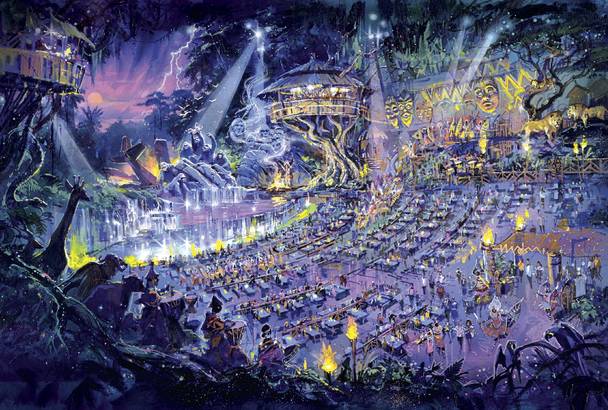
Desert Kingdom, 1993
Desert Kingdom, 1993
Steeped in the legends of lost worlds, this fantasy resort concept by Landmark Entertainment Group has a unique architectural style that combines African and Java-inspired elements. Had it been realized, it might still be in the spot now known as Wynn Las Vegas. While the resort’s main attraction would have been a thrilling riverboat ride through a show space under the main casino, visitors would have also been dazzled by a nighttime water show on the lagoon.
-
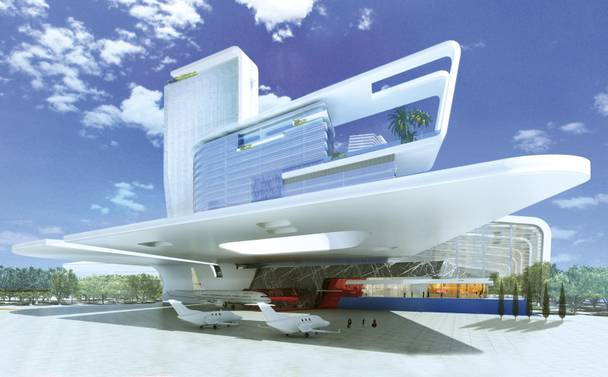
Elysium, 2009
Elysium, 2009
Glass, aluminum, titanium and stainless steel cladding with carbon fiber accents—this conceptual study by Bergman Walls & Associates done for a developer of a resort site adjacent to McCarran International Airport looks like the Vegas of the future. Aircraft as large as a Boeing 737 could park under its space-age canopy, and helicopter crews landing on the roof could relax in the heli-lounge before browsing the private jet dealership.
-

Starship Enterprise, 1992
Starship Enterprise, 1992
This mega-attraction designed by Landmark Entertainment Group would have made the Star Trek fantasy about as real as it gets on Earth, with a life-sized ship as long as France’s Eiffel Tower is tall in permanent dry dock on Fremont Street. From dining Starfleet style to riding a “high-speed travelator” between decks, the sci-fi immersion would have been powerful. And based on this rendering, the evening light show would have been otherworldly.
-
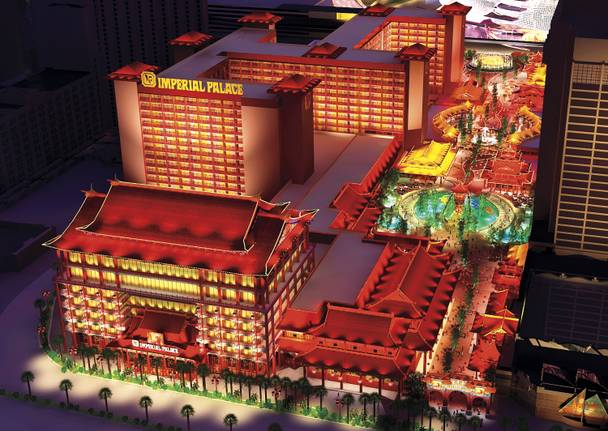
Chinatown Strip, 2009
Chinatown Strip, 2009
Before the plan for Caesars Entertainment’s $550 million Linq project was set in stone, Steelman Partners proposed this design for the planned overhaul of the Imperial Palace. It draws aesthetic inspiration from China’s Ming Dynasty and combines retail, dining, entertainment and vibrant public spaces.
-
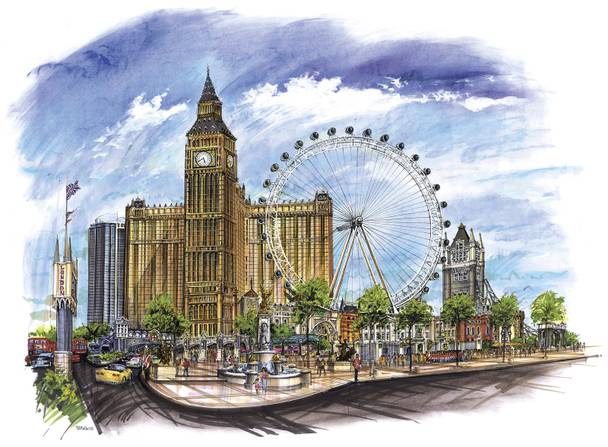
London Hotel Casino, 2001
London Hotel Casino, 2001
On the property now occupied by Fontainebleau, this concept by Bergman Walls & Associates would have brought Vegas the essence of beloved attractions in London, England: Big Ben, the London Eye observation wheel and the Piccadilly shopping experience, as well as a life-sized Tower Bridge and a lobby modeled after Trafalgar Square.
-
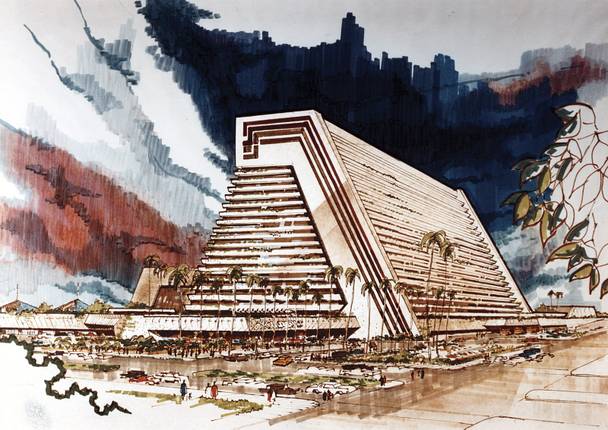
Xanadu, 1975
Xanadu, 1975
With a theme inspired by an old poem about a Mongol conqueror’s “Garden of Delight,” this Martin Stern Jr. design included flame-licked “firefalls” outside and a cinema/buffet/discothèque inside, along with a 20-story atrium full of crystal chandeliers and mirrored surfaces. It also would have been a pioneer in the realm of integrated parking structures on major Las Vegas Boulevard properties.
-
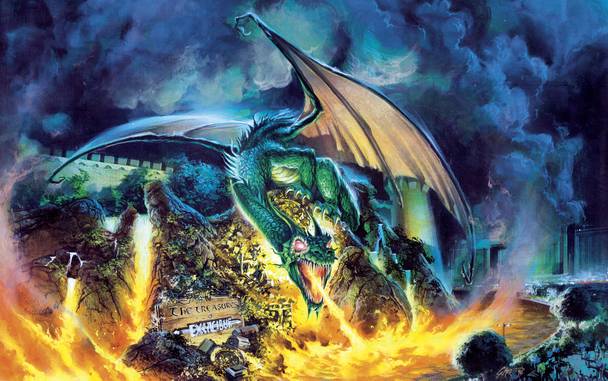
Excalibur Dragon, 1992
Excalibur Dragon, 1992
Designed in response to the Mirage volcano, Landmark Entertainment Group’s dragon concept for Excalibur would have wowed crowds with his sheer size (about as tall as a six-story building). Sleeping part of the time, with his scaled belly rising and falling, he would periodically awaken to roar, spread his wings, swoop down over the moat and blast the water with fireballs to protect the castle’s treasure. Sensing he had done his job, he would give the crowd one last good eyeballing before settling down for a nap.
THE NEW DREAM
That is, unless you’re Gary Goddard. Before he was old enough to drive, he cold-called his idol after finding his number in the White Pages. Les Clark was one of the Nine Old Men, Walt Disney’s original dream team of animators. Goddard called to express his admiration and ask for a meeting, which he got in spades. The kid toured Clark’s Santa Barbara home, then the Disney studio, where the seeds of a powerful, whimsical career were planted.
At 23, Goddard joined the show design group of Disney Imagineering, working shoulder-to-shoulder with the masterminds of beloved attractions such as Pirates of the Caribbean and It’s a Small World and animated characters from Cinderella to Cruella de Vil. At 27, he started his own company. With partner Tony Christopher, Goddard built the reputation of Landmark Entertainment Group on some of the biggest attractions ever to hit Six Flags and Universal Studios, from Terminator 2/3D to Jurassic Park: The Ride. He’s produced musicals for Broadway, created cartoon and live action series for television and written and directed films for major Hollywood studios. And his latest casino design project is one of Macau’s hottest properties, the $2 billion Galaxy, with its 24-carat gold cupolas and sky-piercing laser show.
Goddard’s pixie dust is all over the Strip, too. In fact, he created a 10-year master plan for Caesars Palace, working directly with former chairman Henry Gluck on plans for the towers and exterior enhancements as well as such signature features as the Forum Shops, Olympic Boulevard, the Forum Casino, the Coliseum and Caesar's Magical Empire. Goddard says Gluck called him his secret weapon, though their first meeting involved a polite disagreement about a proposed animatronic Caesar meant to entice people onto the moving walkway. Basically, Goddard told Gluck it would turn one of the Strip’s greatest casinos into Chuck E. Cheese.
The $30,000 budget for the Caesar figure turned into $3 million for a lavish pavilion that transported tourists to ancient Rome. Instead of doubling the number the walkway drew per day, which was the goal, it multiplied it by more than 10. “Henry told me that it paid for itself in six months” Goddard says. “That’s the power of design.”
But the polite arguments don’t always go his way. Six years before Landmark’s Star Trek: The Experience started its decade-long run at the Hilton, Goddard was finalizing plans for another Las Vegas attraction inspired by the sci-fi favorite: a full-scale Enterprise that would have been parked at the mouth of Fremont. According to a Goddard Group blog post that turned into a viral news story this spring—ending 20 years of silence on Goddard’s part—the starship beat out the lighted canopy for a chance to be Downtown’s Hail Mary pass to compete with the Strip.
In 1992, after five months of work, Goddard presented Landmark’s vision to the man who was essentially the last domino. From my story following the post heard ’round the world: A licensing agreement with Paramount had the blessing of the studio’s president, but the final word belonged to CEO Stanley Jaffe. That word was no. … So, Downtown got the Fremont Street Experience, and Goddard suffered “a great personal, creative and emotional loss.”
In the wake of that blow, the ITT Sheraton hired Landmark to design an exotic paradise called the Desert Kingdom. The cavernous casino divided into four themed gaming rooms for an experience-inside-an-experience effect. Goddard says the signature spectacle was the River Adventure, a boat ride that plunged under the main casino through a series of dazzling hidden treasures. The lush lagoon featured a water show, and legends of lost kingdoms would have come to life in a completely immersive theatre. (To give you an idea of how Goddard defines “immersive,” his concept for Phantom-The Las Vegas Spectacular included literally flooding the auditorium when the action turned to the canals under the stage.) “Action happened above you, around you—the show really was everywhere,” Goddard says.
Landmark was deep in the design process; ITT Sheraton was paying the firm millions of dollars and had already hired a construction company, which was poised to dig foundations. Then, out of the blue, ITT Sheraton bought Caesars. The investment was huge, and after a few months of waffling they cut their losses on the dream of the Desert Kingdom. “It’s too bad, because that ITT Sheraton Desert Kingdom would have revolutionized everything,” Goddard says. “There are still things there today that haven’t been done.”
He sheds no tears when he walks Las Vegas Boulevard and doesn’t see it, or the six-story, fire-spitting guard dragon that would have taken Excalibur’s theme to a new dimension. Some things don’t happen. That’s the business. But there’s a gnawing insecurity on the Strip these days that makes Goddard wistful. The recession knocked it down hard. Competition is everywhere. And great pioneers like Steve Wynn seem to have a toe here and the rest in Macau. Goddard calls Wynn “the Walt Disney of Las Vegas” for the way he takes chances, trusts his gut and does everything first class. He also calls him the last of the showmen.
The next generation appears to be all about clean, contemporary, Frank Lloyd Wright austerity. It is cool. But is it Las Vegas? If the fantasy erodes too much into reality, however stylish, will we be just another big city?
“What people don’t understand is, Las Vegas is not about architecture; it’s about theatre. … The market there, if you walk the streets, which I do every time I go to Vegas, it’s basically the same people that are going to Walt Disney World. And what they want to see is things that take their breath away, that surprise them, that awe them, that make them laugh, that stun them,” Goddard says. “Las Vegas is fueled by one thing—bigger than life ideas. And my whole point is, if you can see it somewhere else, then don’t do it in Las Vegas.”
Easy for him to say, Goddard admits. But he sincerely believes that if it stops retreating, Las Vegas can rise again. The city needs new visionaries who think of the Strip like Steelman does, as a “historic road in America.” Not historic in the sense that every outrageous detail should be preserved forever, but in the sense that the singular essence should endure and evolve. You see it in the old renderings. Vividly cartoonish and overwhelmingly hopeful, they reveal where we wish we could be, and who we already are.
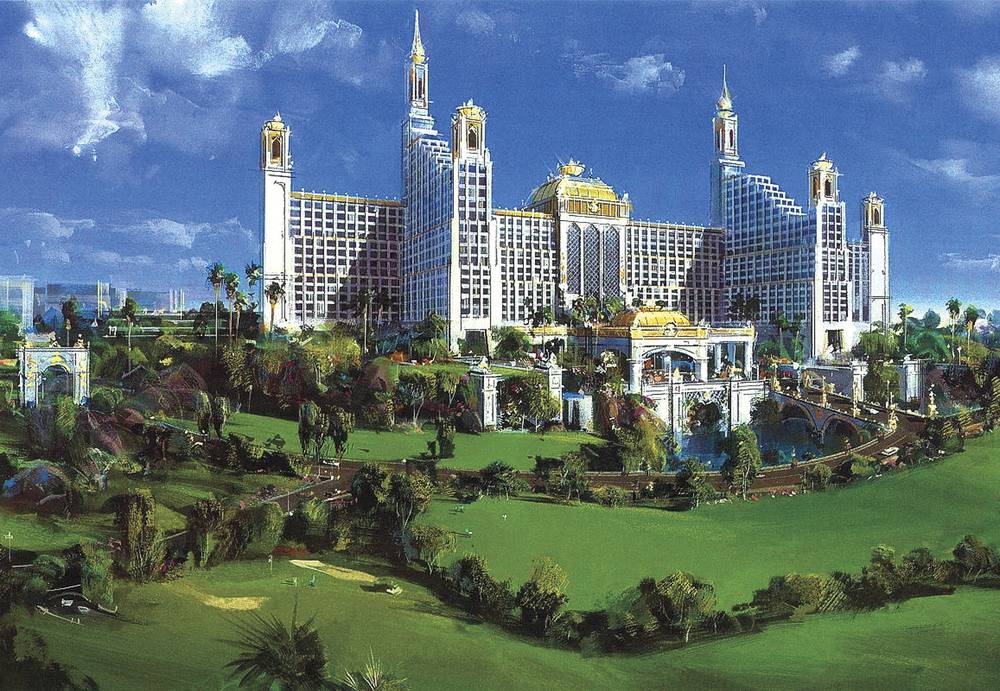

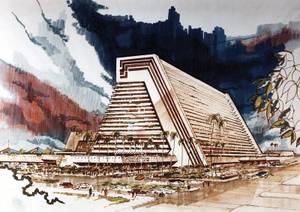







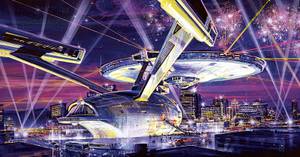

Previous Discussion: